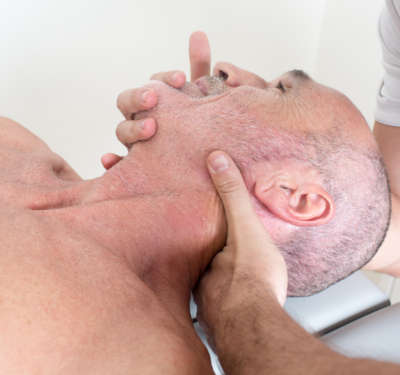Chiropractic manipulations gone wrong
Chiropractic neck manipulations can lead to tears in the inner walls of blood vessels that feed the brain, say researchers.
Published online 30 March 2016

Neck manipulation, when offered by someone without proper training or experience, can lead to serious problems.
© Adam G. Gregor / Alamy Stock Photo
Neurologists in Qatar report in the Qatar Medical Journal that a 55-year-old man was admitted to their hospital with a stroke that occurred one week after undergoing chiropractic neck manipulation to resolve chronic neck pain1.
His symptoms started with acute neck pain followed by sudden weakness of the right side of his body and difficulty in speaking. Within 24 hours he was experiencing full right-sided paralysis and a deterioration of consciousness. MRI scans revealed tears in the inner walls of some arteries in his neck, ultimately blocking the blood supply to parts of his brain. Large parts of the brain supplied by these arteries were spared, nevertheless, causing the team of neurologists to believe interconnections between arteries made up for the deficit.
Cervical artery dissection (CeAD) is a condition that involves tearing in the internal walls of the blood vessels of the neck. Blood accumulates between the layers of the artery’s wall, obstructing blood flow and potentially forming clots. This, in turn, decreases the blood supply to the brain, causing stroke. CeAD is a common cause of ‘ischaemic’ stroke, a stroke caused by an inadequate blood supply, in people under 45. Simultaneous dissection of several neck arteries however — as was the case with the patient in Qatar — is rare.
Barbers and massage parlours in the Middle East often offer neck manipulation to relieve neck pain. But a lack in qualifications and proper training can lead to serious complications. Neck manipulations can cause overstretching of the blood vessels in the neck, leading to internal tears.
The prognosis of CeAD cases is generally good, with symptoms in most patients eventually resolving. However, significant neurologic complications or even death from a massive stroke occur in 2 to 5% of patients.
The patient in Qatar was placed under intensive care and treated with medications to prevent blood clot formation and manage his blood pressure. Within 48 hours his level of consciousness improved and he was able to communicate and perform limited movements in his right hand and foot. He was discharged from the hospital three weeks after he was admitted to begin rehabilitation.
“It would be worthy to restrict cervical manipulation only to those qualified professionals with medical training [who are] aware of its potential risks”, write the neurologists. However, since this is not always practical, they recommend organizing mandatory educational programmes and training for practitioners who conduct neck manipulations.
Reference
- Melikyan, G., Kamran, S., Akhtar, N., Deleu, D. & Miyares, F. R. Cortex-sparing infarction in triple cervical artery dissection following chiropractic neck manipulation. Qatar Med. J. 2015, 16 (2015). | article
DOI: 10.1038/qsh.2016.106

